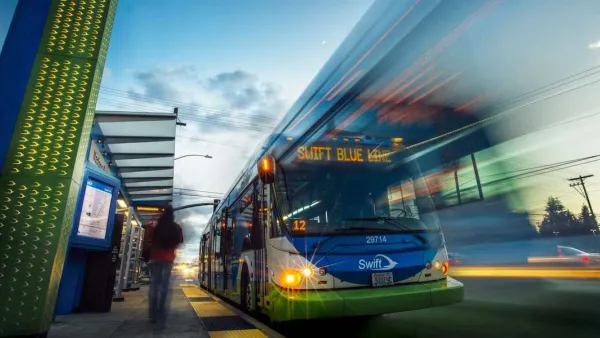The Orange Line, a bus rapid transit line running through Los Angeles' San Fernando Valley, has been a success. To those calling for an expensive conversion to rail, several experts say, why bother?

Dating from 2005, L.A.'s Orange Line now serves more than 25,000 riders a day. Patrick Sisson writes, "In its 12 years of service, the Orange Line has carried more than 74 million passengers and proven there's an audience and ridership in the region. It's so successful that it's often crowded at rush hour, leading Metro to explore an upgrade."
Calls for a light rail replacement have encountered pushback from many experts. "The push to lay down track and replace a successful bus line begs another question: Can a bus line, even with all the right support, ever be enough?"
Juan Matute, associate director of UCLA's Lewis Center and the Institute of Transportation Studies, says the Orange Line has succeeded on many levels. "'The Orange Line has been an extremely cost effective transportation amenity,' [Matute] says. 'You could build five Orange Lines for the cost of a light rail corridor.'"
Rail advocates argue that the conversion will spur efficiency gains. It'll also cost an estimated $1.4 billion. Sisson writes, "If the bus line were treated like rail, instead of being replaced by rail, the transit authority could accomplish many of the same efficiency gains at a much lower cost."
FULL STORY: Can the Valley’s Orange Line—the nation’s most successful BRT—get any respect?

National Parks Layoffs Will Cause Communities to Lose Billions
Thousands of essential park workers were laid off this week, just before the busy spring break season.

Retro-silient?: America’s First “Eco-burb,” The Woodlands Turns 50
A master-planned community north of Houston offers lessons on green infrastructure and resilient design, but falls short of its founder’s lofty affordability and walkability goals.

Delivering for America Plan Will Downgrade Mail Service in at Least 49.5 Percent of Zip Codes
Republican and Democrat lawmakers criticize the plan for its disproportionate negative impact on rural communities.

Test News Post 1
This is a summary

Test News Headline 46
Test for the image on the front page.

Balancing Bombs and Butterflies: How the National Guard Protects a Rare Species
The National Guard at Fort Indiantown Gap uses GIS technology and land management strategies to balance military training with conservation efforts, ensuring the survival of the rare eastern regal fritillary butterfly.
Urban Design for Planners 1: Software Tools
This six-course series explores essential urban design concepts using open source software and equips planners with the tools they need to participate fully in the urban design process.
Planning for Universal Design
Learn the tools for implementing Universal Design in planning regulations.
EMC Planning Group, Inc.
Planetizen
Planetizen
Mpact (formerly Rail~Volution)
Great Falls Development Authority, Inc.
HUDs Office of Policy Development and Research
NYU Wagner Graduate School of Public Service




























